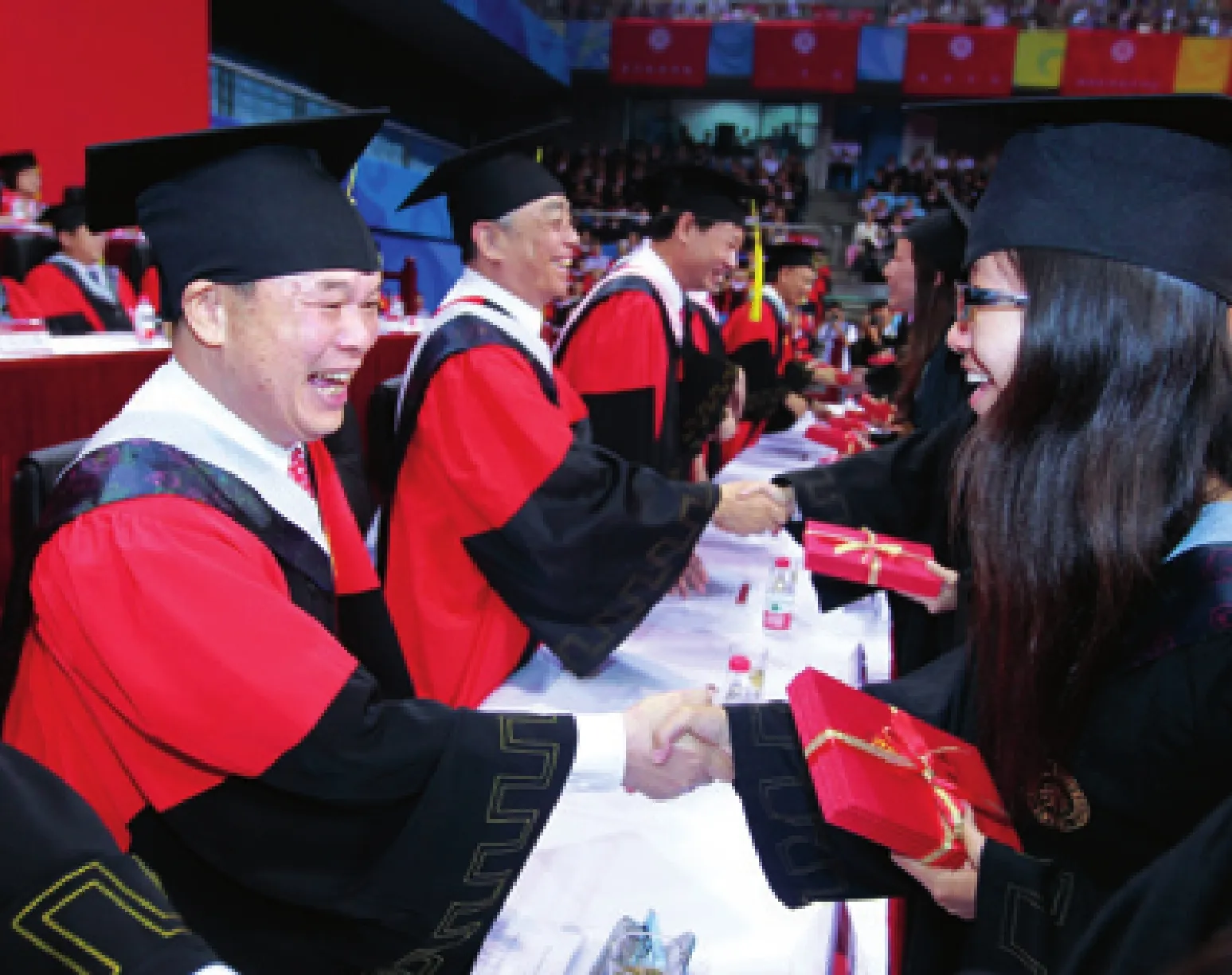An Ambitious Objective
2012-10-14BuildingworldclassuniversitiesislongtermprojectByYinPumin
Building world-class universities is a long-term project By Yin Pumin
An Ambitious Objective
Building world-class universities is a long-term project By Yin Pumin
On February 20, Chen Jining was appointed president of China’s prestigious Tsinghua University in Beijing. Chen is one of a number of new presidents appointed to leading Chinese universities over the past few years.
The new round of appointments to key positions at universities began in 2006. By February this year, 28 universities listed in China’s Project 985 for higher education development and 79 universities covered by the earlier Project 211 had new presidents.In 2011 alone, 10 universities included in the elite Project 985 group had new presidents appointed.
The appointment of new university presidents took place against the backdrop of China’s concerted efforts to establish worldclass universities.
“A new president will always bring about fresh changes to a university and is seen as a main driver of a university’s development,”said Cheng Fangping, a professor at the Education School of the Renmin University of China in Beijing.
As the pinnacle of China’s higher education system, those universities associated with Project 211 and 985 have an urgent responsibility to build themselves into world-class universities.
From 211 to 985
Project 211, initiated in 1993, is a government endeavor to develop about 100 Chinese institutions of higher education into worldclass centers of learning. The fi gure of 21 and 1 within the name 211 are from the abbreviation of the 21st century and approximately 100 universities.
The motivation for the project was the fact that in the 1990s, the country’s 30 elite universities were not maintaining sufficiently high research standards and were therefore poorly regarded internationally. The Chinese Government aimed to cultivate 100 high-level universities to enable the country to implement national economic and social development strategies.
Universities that fall under the scope of Project 211, which totaled 112 at the end of 2011, train 80 percent of the country’s doctoral students, two thirds of its graduate students, half the international students and a third of undergraduates.
In the first three phases of Project 211 between 1995 and 2011, the Central Government invested 17.7 billion yuan ($2.81 billion) in the project.
In 1998, China further concentrated its efforts to create elite universities by launching Project 985, named after the date it was launched on May 5, 1998. This project provided extra funding to 10 universities, and it has now expanded to cover 39 higher learning institutions.
The project aims at creating a core set of universities that can compete effectively in the global arena.
The project was initiated by former Chinese President Jiang Zemin, who said at Peking University’s centenary ceremony on May 4,1998, that “China must have a number of topclass universities at the international level.”
Earlier, former Premier Zhu Rongji said in March 1998 that revitalizing the nation through science and education was the biggest task of his government.
With so much attention focused on higher education, Peking University, following the model of the Knowledge Innovation Program launched by the Chinese Academy of Sciences (CAS), made a policy appeal to the Central Government, in order to receive more support for its future development.
The CAS Knowledge Innovation Program was authorized by the Central Government in February 1998 and received a total of 4.80 billion yuan ($762 million)from the state coffer to support its pilot projects.
“Compared to Project 211, the Knowledge Innovation Program has more centralized objectives with higher construction targets and more funds, which directly inspired and promoted the planning and the establishment of Project 985,” said Chen Xuefei, a professor at the Graduate School of Education of Peking University.
On June 25, 1998, the National Science,Technology and Education Leading Group,led by then Premier Zhu, was officially launched. On October 28 of that year,the leading group held its second work conference and passed the Action Plan for Reinvigorating Education Facing the 21st Century initiated by the Ministry of Education. The focus of the plan was to support an elite group of universities in order to make them world class.
To achieve that goal, the Central Government promised to increase the educational allocation in the national budget by 1 percent a year for each of the fi ve years following 1998.
More funds
In 2004, Xu Zhihong, then President of Peking University, expressed his ambition to have Peking University recognized as a world-class university by 2015.
But lack of funding had long been a main obstacle for Chinese universities as it prevented them from investing in world-class facilities and personnel.
“In 1994, we had only 15 offices and a 30-square-meter of fi ce that was shared by 16 teachers,” said Chen Zhiqiang, Dean of the College of History at Tianjin-based Nankai University.
Actually, conditions in Peking University at the time were similar. “Sometimes a teacher had just one drawer in an office,”said Wang Yiqiu, former Vice President of Peking University. “Besides, due to limited funding, the library of Peking University was unable to purchase foreign books for several years.”
The establishment of Project 985 laid a solid foundation to solve the funding problem.

STUDENTS HONORED: Peking University President Zhou Qifeng awards a diploma to a student at the commencement event on July 5, 2011
Central and local governments have allocated large amounts of funding to these universities to build new research centers,improve facilities, hold international conferences, attract world-renowned faculty and visiting scholars, and finance Chinese faculty’s overseas academic exchanges.
Although the 39 universities included in Project 985 account for less than 2 percent of China’s 2,000 full-time higher education institutions, they hold more than 50 percent of Ph.D. candidates, national key branches of learning and national key laboratories.
“Heavy investment will help push Chinese universities up the world rankings,”said Ying Cheng, Executive Director of the Shanghai Jiao Tong University Center for World-Class Universities.
A long-term goal
The overall strength of Chinese universities,those listed in Project 211 and 985 in particular,has improved considerably in the past decade.
In April 2011, Gu Binglin, former President of Tsinghua University, announced at the university’s centenary ceremony that Tsinghua University had become one of the highest ranked universities in the world, boasting a first-class education and world-leading facilities.
According to the Academic Ranking of World Universities (ARWU) published by Shanghai Jiao Tong University in 2011, Peking and Tsinghua universities ranked at 167th and 178th respectively on the ARWU list.
Since 2003, the ARWU has been listing the world’s top 500 universities annually,based on a set of indicators and third-party data. It is recognized as a reliable indicator of global university rankings.
Ying believes that China, despite weak ratings overall, is en route to creating worldclass universities.
By the ARWU standards Peking and Tsinghua universities can already be considered world class. “Besides, between 2003 and 2010, 20 more Chinese universities had entered the top 500, dethroning just as many American ones,” Ying said.
However, Chinese universities are still lagging behind world-class universities when it comes to cultivating leading researchers and fostering independent innovation.
Some experts argue, however, that more than just universities, the country’s entire education system may be responsible for the weakness of China’s tertiary education.
Zhou Zhong, a professor at Tsinghua University, said that Chinese students are put under tremendous pressure during their school years. They have to prepare for the national college entrance examination that requires huge amounts of memorization,and then at university they feel the pressure of fi nding a promising job after graduation.
“This reduces the quality of China’s intellectual output. Students focus on getting a good job, and earning enough to buy a house.During their college years, they tend to place too much practical value on their choice of subjects and do not focus on quality academic output,” Zhou said.
Ultimately building world-class universities is a long-term project. “Worldclass universities cannot be built overnight,not even in a generation or two,” Peking University’s former President Xu said.
In July 2010, the Central Government set out its educational goals in the National Outline for Medium- and Long-term Educational Reform and Development (2010-20), also known as the 2020 Blueprint. It stated that one of the chief priorities was to raise the global competitiveness of higher education through the creation of world-leading innovative talents,internationally renowned flagship disciplines and world-class universities.
